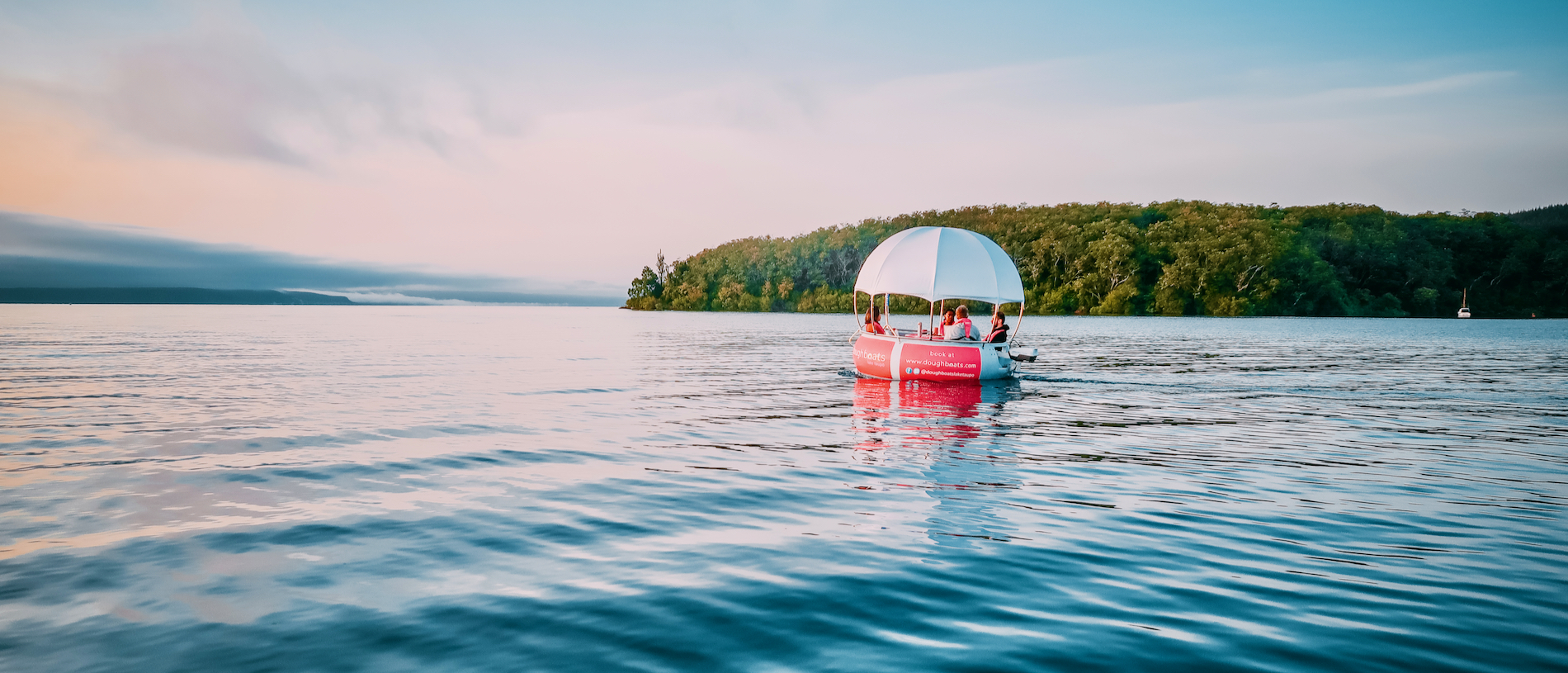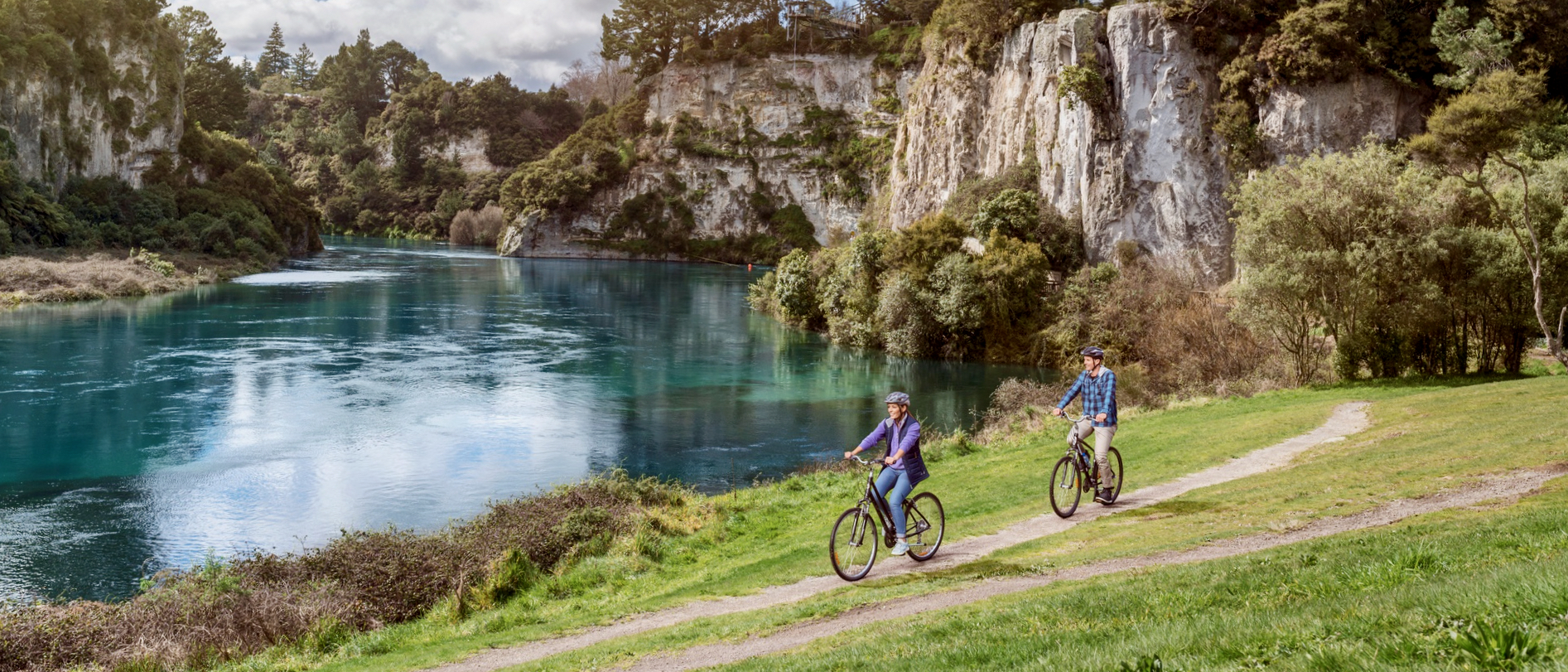
Helm your own Doughboat on Lake Taupō
One of the latest and most striking additions to the Taupō waterfront are Doughboats – inflatable doughnut-shaped boats with room for up to six people to cruise the inner reaches of the Great Lake.

Stretching from the coast at Whanganui to the mountains of Tongariro National Park and the waters of Lake Taupō, there is so much to discover in the Central North Island. Check out these 17 fantastic Kiwi Gems that you probably didn't know existed.
Ngātoroirangi Mine Bay Maori rock carvings, on Lake Taupō, are something else. They tower above the lake, etched into high cliff faces, defying rationale. How did they get there? And how do you get there? They’re only accessible by boat, so that’s one question answered. Various boat tours from Taupō Boat Harbour will take you to Mine Bay to view the large face of Ngātoroirangi and various small companion figures; paddling your own kayak is an even better option because you can get much closer to the carvings. How the art got there is not such a mystery. Although they look ancient, they were carved in the 1970s by a team lead by Matahi Whakataka-Brightwell using power tools.
The Western Bays of Lake Taupō that extend from Kinloch can only be reached on the Great Lake Cycle Trail that wraps around the lake’s perimeter – or by boat. The lake itself is massive with a shoreline stretching 195km and a surface area the size of Singapore. Onboard a Western Bay Taster cruise with Taxicat Adventures you’ll get to experience the secret spots that are otherwise inaccessible. Think incredibly clear water – jewel-toned as it reflects off the pale pumice bottom – phenomenal rock formations in the soaring rhyolite cliffs popular with climbers, ravines and frothing waterfalls that tumble into the lake. Otupoto Falls is the largest waterfall discharging into the lake and you’ll get close enough to touch it as the boat noses into the narrow crevice of rock. Ashore at Kotukutuku Bay you can take a short bush walk to discover another waterfall which is particularly impressive after rain. The trip also includes a picnic stop on a pristine, deserted beach with freshly brewed local coffee or hot chocolate.

The best way to explore the 14km loop from Huka Falls to Aratiatia Dam is by e-bike. Although the trail is a Grade 2-3, so relatively easy going and family-friendly, the electric boost is a welcome addition to get you up some of the steeper hills. Hire bikes from the team at FourB at The Hub and set off on riverside adventure bookended by the phenomenal power of the river at Huka Falls and, if you time it right, the Aratiatia hydroelectric dam release. Parts of the trail wind through bush and can get muddy, so be prepared for splatters, but the riverside pumice paths are generally flat and fun. Along the way you’ll get great vantage points over the Huka Prawn Park and in behind Wairākei Resort a rest stop to soak your feet in the warm geothermal waters of the stream is recommended!
This is a mysterious spot that’s well off the beaten track. Locals keep this picturesque swimming hole a closely-guarded secret, and in fact it’s known by several different names. The Champagne Pools aka the Fairy Pond aka the Lost Lagoon is a deep underground spring emerging in a bush clearing on the outskirts of Tūrangi. With crystalline water so clear you can see all the stones on the bottom and natural rock formations perfect for leaping off, it’s worth making the effort to seek out this special pool. Be warned, the spring water is icy cold year-round. From Kuratau, about 30km north west of Tūrangi, park towards the end of Kuratau Hydro Road – if you get to the power station you’ve gone too far. Follow the stream, and the lagoon can be reached on a ten-minute walk through the bush on a faintly-marked track.

For a mostly flat, family-friendly ride that takes you alongside the majestic Tongariro River, hit the Tongariro River Trail. The Grade 2 ride takes in native bush, rolling farmland and wonderful vistas of the river on a 15km loop. The one significant climb takes you to the Tongariro River Lookout for sprawling views of Tongariro National Park that make the effort well worthwhile. Ride the trail in either direction, and if you’re only up for a short excursion, there are several entry and exit points, so you can dip in or out when you’ve had enough. Two convenient underpasses let you complete the circuit without needing to cross SH1.
Take an easy stroll around little Lake Rotopounamu south west of Tūrangi. The former volcanic caldera that sits alongside larger Lake Rotoaira is rich in biodiversity and makes a great pitstop on a North Island road trip. From rare native birdlife including toutouwai / North Island robin, tītīpounamu / rifleman and kōmiromiro / tomtit, to examples of beautiful podocarp, beech and broadleaf forest, the two-hour walk that circumnavigates the lake is a rich and rewarding nature experience. If you’re pressed for time, turn left at the first junction and you’ll end up at Ten Minute Beach, which is lovely for a lakeside picnic or a refreshing dip in summer.

Do not miss Horopito Motors when visiting Ruapehu. This iconic mechanic shop and car wrecker’s yard was made famous by the 1982 film Smash Palace and more recently was the setting for the climactic chase scene in Hunt For the Wilderpeople. It is a treasure trove of vintage parts and car carcasses – around 5,500 of them on site, says owner Colin Fredrickson. Inside, you can wander amongst teetering rows of bumpers and bonnets, headlights and hubcaps. Outside, marvel at the sheer number of rusting wrecks. Despite the seemingly chaotic nature, Colin says the team can get any car out from any improbable pile within three hours – because even the most decrepit looking vehicles are still used as a source for parts in the workshop.
Accessed from the road that takes you to the Whakapapa ski field, the Silica Rapids Walk is a 7km, 2.5-hour loop that takes in some of Tongariro National Park’s most curious and colourful natural attractions. Multi-coloured streams run through alpine tussock and burble alongside the well-formed track. And deeper, in the heart of the beech forest, you’ll find cascading waterfalls that are so bright with mineral deposits they’re almost lurid. The colours here are caused by various trace elements emerging from the depths of the volcanic earth. Aluminium makes for pale, creamy colours below the rushing water, while deposits of iron turn to bright orange rust. The walk is easiest when tackled from the top of the road and winding back down to the Whakapapa Village, but to do that, it’s best to have a vehicle parked at either end.

The National Army Museum in Waiouru is a popular spot for families when the weather doesn’t permit a trip up the mountain. But you should add it to your list of Must-Do attractions in Ruapehu even if the sun is shining. A fascinating journey through New Zealand’s military history, the museum is home to world-class exhibitions and incredible stories. Immersive exhibits include the topical Death Ship, telling the story of the 1918 Spanish flu outbreak with parallels to the Covid pandemic. Unnerving sound effects of coughing play through speakers. In another exhibition, the distinct smell of antiseptic wafts from an interactive infirmary. Alongside these multi-sensory experiences, the Army Museum also has sobering reminders of the cost of war, like the audio recording playing the names of those killed in combat which takes two whole weeks to run through.
A day walk to rival the popular and often busy Tongariro Alpine Crossing, the Tama Lakes track takes you through beautiful alpine landscapes without the crowds. Continue on from the shorter Taranaki Falls track that begins at Whakapapa Village to make your way to the lakes – former volcanic explosion craters on the saddle between Mount Ruapehu and Mount Ngāuruhoe. You’ll experience open tussock land and alpine herbs growing alongside the well-maintained track. Later, the trail becomes more rugged, so you’ll want to come prepared with good boots and while the Tama Lakes Track is less exposed than the Tongariro Crossing, with fewer steep uphill sections, you'll still need gear suitable for changeable weather conditions.

Another collection of mysterious spherical boulders, similar to the famous ones in Moeraki or Koutu in Northland, can be found in a forest glade on a farm in rural Ohingaiti – an hour and a half north of Palmerston North. The remote location is part of the intrigue. Unlike their coastal counterparts, the perfectly round Whitecliffs Boulders are covered in moss which adds to the feeling of stepping into a fairytale. For a small fee, visitors can take a self-guided walk through farmland and into the valley where the boulders are found. Known as concretions, the boulders were formed by small blocks of mudstone combined with calcite crystals that grew to become erosion-resistant boulders. The size of the Whitecliffs concretions suggests that this process may have taken tens of thousands of years. But why they are all gathered into a very small area on the valley floor remains a mystery.
A true hidden gem about 45 minutes drive through the countryside south east of Dannevirke, Waihi Falls is a stunning waterfall, popular for a refreshing summer dip. The 25-metre-high falls cascade over a rocky cliff into a deep swimming hole, and there are several ledges beneath the falls to climb and jump off. Surrounded by grassy areas for picnicking and reached via a well-formed track from a car park, a visit to Waihi Falls makes for a great day out.

Te Awahou Nieuwe Stroom in Foxton is the only tri-lingual cultural institution in New Zealand, with interpretative signage throughout the museum and gallery in English, Māori and Dutch. The Dutch connection with New Zealand all began with Abel Tasman, way back in 1642. However, in the early 20th century many Dutch immigrants were forced to spread out around the country so they integrated with New Zealand society and didn’t congregate in one region. Part of the purpose of Te Awahou Nieuwe Stroom is as a Dutch connection centre, designed to bring these disparate communities back together. The museum is created to appeal to all ages, with exhibits at different levels for children to discover. There are doors to open, Dutch spices to smell, things to touch – a full multi-sensory experience.
Another swimming spot worth checking out on a hot summer’s day is the human-made Mangaweka Dam on the Mangawharaiki River. A curved 10-metre-high concrete dam was constructed here in the early 1900s to serve as a water reservoir and power source for the Mangaweka area. Today, the area, which still has the original power house nearby as well as interesting remnants of the power station’s early engineering, is a great swimming hole. To get there, turn off SH1 at the north end of Mangaweka onto the Manawatū Scenic Route. Shortly after crossing the Rangitīkei River turn left on the Kawhatau Valley Road and travel about 200 metres to the parking area for the power station just before the bridge.

From the outside, St Paul’s Church in the Whanganui suburb of Putiki appears to be a standard white Anglican church. However, when you step through the doors on a guided tour (book at the Whanganui iSITE) the interior is anything but ordinary. Rich in Māori history and entirely clad in ornate tukutuku panels on the walls and ceiling, the church tells of the culture, religion and mythology of the Whanganui region. Every patterned panel tells its own story with stained glass windows fusing Pākehā and Māori iconography in a beautiful, spiritual space.
This sprawling 25-hectare site on Rapanui Road as you head towards Kai Iwi Beach in Whanganui is a delightful collection of exotic plants and groomed green spaces. You’ll know you’re in the right place with the distinctive steel and glass archway at the entrance. With eight distinct zones, the Bason Botanic Gardens include native bush, a scenic lake and homestead gardens. The architecturally designed conservatories were built using recycled bricks from a city theatre and now stage tropical plants, begonias and a collection of cooler climate orchids. Donated to the city by Stanley and Blanche Bason in 1969, the Bason Botanic Gardens are now maintained by the Whanganui District Council and are free to visit.
In the cultural heart of Whanganui, Pukenamu / Queen’s Park, the Whanganui Regional Museum is housed in a beautiful heritage building that has recently re-opened after a refurbishment and seismic strengthening. With an impressive Taonga Māori collection tracing the rich cultural history of the region sitting alongside regularly changing exhibitions, the museum provides a wealth of information about the things that make Whanganui unique. Learn about how the river was once known as the ‘Rhine of the Antipodes’ and marvel at the extensive array of zoological exhibits in the ‘Teeth, Talons and Taxidermy’ exhibit.
Want more inspiration? What about these Must-Do's while you're here: